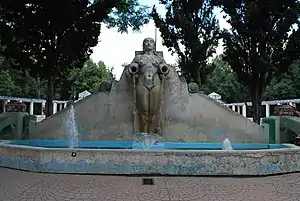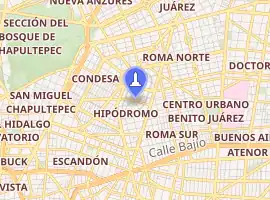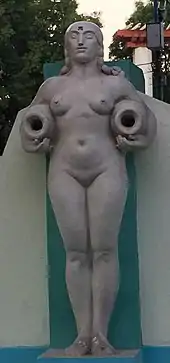Fuente de los Cántaros
Fuente de los Cántaros is an outdoor fountain and sculpture of an indigenous woman in Mexico City's Parque México, in Mexico, created by José María Hernández Urbina in 1927, and restored in 2008.
| Fuente de los Cántaros | |
|---|---|
 The fountain and sculpture, 2010 | |

| |
| Artist | José María Hernández Urbina |
| Year | c. 1927 |
| Medium | concrete |
| Dimensions | 300 cm (120 in) |
| Condition | Restored |
| Location | Parque México, Mexico City, Mexico |
| 19°24′41.3″N 99°10′10.77″W | |

Description and history
The fountain was created by José María Hernández Urbina, with Luz Jiménez, an indigenous Nahua woman, as the model, in 1927. The statue, 3 m in height[1] and constructed from concrete,[2] depicts a naked woman with a water pitcher under each arm, from which the water flowed. Locally she is referred to as La Muñeca or the Mujer de los Cántaros.[2][3] The fountain faces onto Calle de Michoacán, which divides the park, at the entrance to the Teatro al Aire Libre Lindbergh (Lindbergh Forum, named for Charles Lindbergh).[lower-alpha 1] Urbina, together with the architect Roberto Montenegro was one of the creators of the Forum, with its Art Deco features, in the 1920s, at the time that Colonia Condesa was being developed. The statue has come to symbolize the Mexican people (Mexicayotl or Mexicanidad) before The Conquest. The Forum was poorly maintained, and fell into disrepair, but in 2008 a restoration began at a cost of 21 million pesos over 17 months, but was considered controversial by local residents.[5] The fountain is considered an important landmark and attracts many visitors.[6][7]
In popular culture
The statue has become symbolised in stencil graffiti on the walls of Mexico City,[8] and has been replicated in fibreglass for a film and is a frequent subject for artists.[5]
See also
Notes
- Lindbergh landed his plane, Spirit of St. Louis in Mexico City on 13 December 1927, after leaving Washington DC, and the event was commemorated by naming the forum after him[3][4]
References
Bibliography
- Garcia, Marisol Flores (2002). "Parque México o San Martin". Guía de recorridos urbanos de la colonia hipódromo. Universidad Iberoamericana. pp. 130–135. ISBN 978-968-859-468-1.CS1 maint: ref=harv (link)
- "Mexico's Most Famous Model". Scraper. 2015. Retrieved 5 March 2020.
- Diaz, Pedro (21 January 2019). "El Parque México, el emblema inolvidable de la Ciudad". Excélsior (in Spanish). Retrieved 5 March 2020.CS1 maint: ref=harv (link)
- Quintero, Josefina (10 September 2008). "En el parque México, ecocidio, no rescate, aseguran colonos". La Jornada (in Spanish). Retrieved 5 March 2020.CS1 maint: ref=harv (link)
- "La fuente de los cántaros: Parque México". ComARevista (in Spanish). Universidad Anáhuac. 9 February 2017. Retrieved 5 March 2020.
- "La fuente de los Cántaros". Punto Destino (in Spanish). Retrieved 5 March 2020.
- Potters, Cristina (15 March 2014). "Stencil Graffiti: Art and Politics on Mexico's Walls". Mexico Cooks!. Retrieved 5 March 2020.CS1 maint: ref=harv (link)
- "La Mujer de los Cántaros". Vida de Peatón (in Spanish). 6 January 2011. Retrieved 5 March 2020.
- "Fuente de los Cántaros". Wizards Unite World Map. Retrieved 6 March 2020.(map)
External links
 Media related to Fuente de los Cántaros at Wikimedia Commons
Media related to Fuente de los Cántaros at Wikimedia Commons